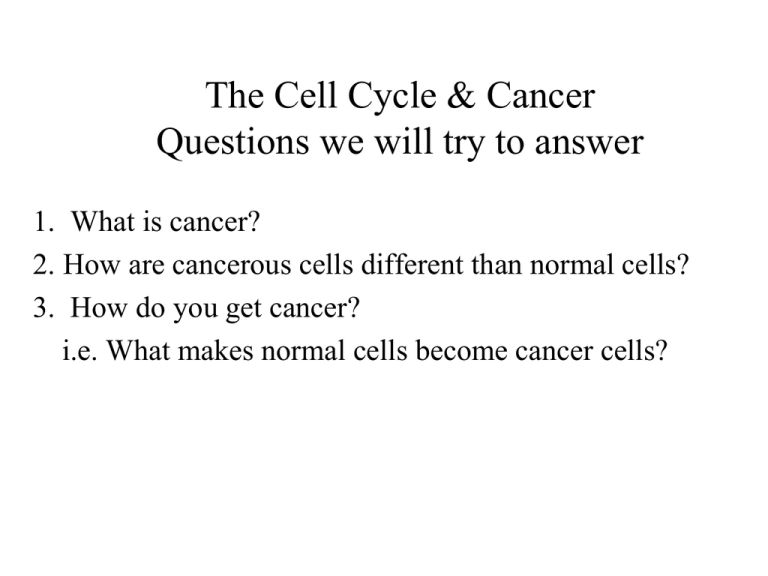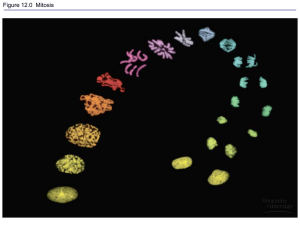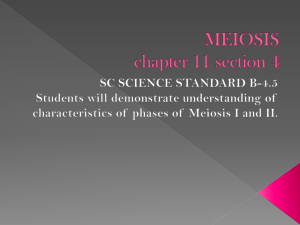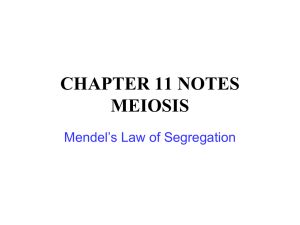
The Cell Cycle & Cancer
Questions we will try to answer
1. What is cancer?
2. How are cancerous cells different than normal cells?
3. How do you get cancer?
i.e. What makes normal cells become cancer cells?
What is cancer?
• Cancer is …
• Cancer cells cannot stop dividing
• Cell cycle
Fig 8.7
The Events of the Interphase
• Interphase:
• Divided into 3 phases:
G1 –
S–
G2 –
• Length of G1 can vary greatly:
Cell Division or “M” phase
• Cell Division consists of two parts
1. Mitosis:
2. Cytokinesis:
• What needs to happen to the chromosomes prior
to Mitosis?
• During mitosis?
Fig 8.6
Sketch of one duplicated chromosome
Each chromatid has one
DNA molecule
1.
2.
How do
sister
chromatids
compare
genetically?
What
happens to
sister
chromatids
during
mitosis?
Sister chromatids
Centromere
Mitosis: sister chromatids separate
Two-chromatid
chromosome
One-chromatid
chromosome
One-chromatid
chromosome
S-Phase: DNA Replication
Interphase
•
Mitosis: Division of the Nucleus
Four Stages:
1. Prophase –
2. Metaphase –
3. Anaphase –centromeres break and the chromosomes
(now single chromatids) migrate to opposite poles
4. Telophase – nuclear envelope forms around each cluster
of chromosomes
Fig 8.8
Cytokinesis: division of the cytoplasm to
create 2 new cells
Fig 8.9
• Mitosis
– Produces somatic
(body) cells
• Meiosis
– produces gametes
Fig 8.14
• Karyotype =
• How many pairs of
chromosomes in this
Karyotype?
• Paired chromosomes are
homologous
• How do you inherit
chromosomes?
• What gender?
• Sex vs. autosomal
chromosomes?
Normal Karyotype
of Human
Chromosomes
Sex chromosomes
determine a person’s gender
• Humans have 46
chromosomes:
• Sex chromosomes:
Diploid cell: 6 total
chromosomes, 3 sets of
homologous
chromosomes
Haploid cell
One set of
non-homologous
chromosomes
Haploid cell
One set of nonhomologous
chromosomes
Regulation of Cell Division
• What evidence in your own life do you have that cell
division is regulated
by your body?
• What normally controls cell division?
Contact Inhibition
• Cells do not normally grow or divide when in
contact w/ other cells
Contact inhibition
does not occur in Cancerous Cells
• Cancerous cells continue growing and moving
when they touch other cells.
Fig 8.10
Cell cycle control
Growth control in a normal cell
Signaling cell
Growth factor =
Growth factor binds to receptor
Receptor sets off
a signal
cascade to
nucleus
target cell
Nucleus
target cell enters
S-phase and
divides,
eventually
repairing
wound
Several ways to get faulty growth control in a cancer cell
2. Mutant receptor might
turn on even without
binding growth factor
1. Cell might
produce
its own
growth
factor
3. Signal cascade
might occur even
without trigger
from receptor
The genetic basis of cancer (p.224-227 in Ch 11)
• Proto-oncogenes:
• Oncogenes:
– genes that cause cancer
• Oncogenes are rarely inherited.....Why?
Tumor Suppressor Genes
• Tumor Suppressor Genes
• One mutant Tumor Suppressor Gene does not
cause cancer....Why?
Fig. 11.20
BRCA 1: Breast Cancer Susceptibility Gene
• BRCA 1 is ….
• If a women inherits a mutant BRCA 1 she has a
– 80 to 90% chance of developing breast cancer
– Why aren’t the percentages 100%?
• Why are the percentages (10%) much lower for
the average woman?
Environmental causes of cancer
1. Viruses
2. Chemicals
3. Radiation
**All can cause mutations in tumor-suppressor genes and
proto-oncogenes
Characteristics of all cancer cells
1.
2.
3.
4.
5.
Immortal
Altered cell membranes
Have lost the genetic ability to stop dividing
Cancer is heritable:
Are dedifferentiated
6. No contact inhibition
7. If not treated will eventually cause death
Cancer treatment:
Attack Actively Dividing Cells
•
Three treatments for cancer:
1. Surgery
2. Radiation
3. Phase-specific chemotherapies
Phase-specific Chemotherapies
1. Prevent cells from entering the S-phase
2. Block the S phase
3. Block or stop mitosis
But chemotherapy can’t discriminate
between cancer cells and normal cells….
• May affect all rapidly dividing cells
• Which cells divide rapidly?
• So.... what would be the side effects?
Side Effects of Chemotherapy
How to lower your Cancer Risks
• Eat plenty of fiber
– Fiber speeds passage through digestive tract
• Do not smoke
• Drink alcohol in moderation or not at all
• Exercise regularly
• Do not become overweight
• Limit dietary fat
• Limit sun exposure or use sunscreen
• Learn to recognize the warning signs of cancer
Common Warning Signs of Cancer:
C.A.U.T.I.O.N.
C - change in bowel or bladder habits
A - a sore that does not heal
U - unusual bleeding or discharge
T - thickening or lump in the breast or any part of the
body
I - indigestion or difficulty swallowing
O - obvious change in a wart or mole
N - nagging cough or hoarseness
Down Syndrome - Incidence with
Mother’s age
• 1 in 1000 births in U.S.
• 1 in 12 births for moms that are 50 years old
• Most frequent genetic cause of mental
retardation
– I.Q. = 20-50
Down Syndrome
as function of mother’s age – Fig 8.23
Human Somatic
Cells have 46
Chromosomes
• How many
chromosomes in
human gametes?
Down Syndrome
Meiosis
Down Syndrome
Karyotype
• What is wrong with
the Karyotype?
• Why are most
trisomies fatal?
(except sex
chromo’s)
Human Life Cycle
• Meiosis
• What if gametes
were made by
mitosis?
Fig 8.14
Fig 8.15
Fig 8.16 Meiosis I
Stages of Meoisis
1. Interphase –
2. Meiosis I
a) Prophase I –
b) Metaphase I –
c) Anaphase I –
d) Telophase I –
3. Meiosis II
a) Prophase II – chromosomes attach to spindle
b) Metaphase II – chromosomes align at equator
c) Anaphase II – sister chromatids separate
d) Telophase II – cells divide, end result = 4 haploid
daughter cells
Interphase
Normal Meiosis
• How do the chromo’s align
at metaphase I?
diploid
2n
• What separates at
anaphase I?
• How do the chromo’s align
at metaphase II?
• What separates at
anaphase II?
n
Meiosis I
n
Meiosis II
n
n
n
n
Fig 8.17
Normal Meiosis followed by Fertilization
Meiosis I
Meiosis II
Product of
meiosis
Fertilization
Zygote
Normal sperm
Chromosomes:
Both daughter cells
have one copy of
each chromosome
Normal diploid
zygote
Genetic Basis of Down Syndrome:
Nondisjunction:
- in Meiosis I:
- Or
- In Meiosis II:
Fig 8.20
Age of Mom vs. Age of Dad
• Why is the age of the mother, but not the father,
correlated with the probability of having a child
with Down Syndrome?
Egg formation in humans
• Pre-egg cells present before girls are born -about 1000 or so.
• Pre-egg cells are stuck at metaphase I
• Ovulation:
Mom’s Pre-egg Cells form Prenatally
• Half of you was present inside your grandmother as a
single cell inside your mom when she was a fetus.
• At about 12 years, women start ovulating one egg each
month for next 40 years.
• So …..A 50 yr old woman has had her eggs sitting with
chromosomes aligned in metaphase for over 50 years!
• Nondisjunction is rarely seen with chromosomes larger
than #20--Why?
.
Why doesn’t the age of the father influence the
rate of Down syndrome?
• Sex cell formation in Males:
Genetic Screening for Down Syndrome
• Can we detect D.S. before birth?
• Amniocentesis: fetus located using ultrasound, needle
inserted and amniotic fluid extracted
– Fluid contains fetal urine and fetal cells from skin,
respiratory tract, urinary tract
– Make karyotype to detect abnormal chromosome
numbers.
• Not performed until 16th week of pregnancy
Chorionic Villus Sampling (CVS)
• Catheter inserted vaginally and chorionic tissue
removed
• 9-11 weeks after conception results of tests
within days rather than weeks as in
amniocentesis
• But may be slightly riskier for fetus
Meiosis Causes Genetic Variation
1. Independent Assortment
– =
–
–
Thus maternal and paternal chromosomes are
shuffled
223 or 8,388,608 different possibilities from each
parent, then fertilization gives 70 trillion
Fig. 8.18
2nd Reason for Genetic Variation
2. Crossing over
–
Result:
Fig 8.19










